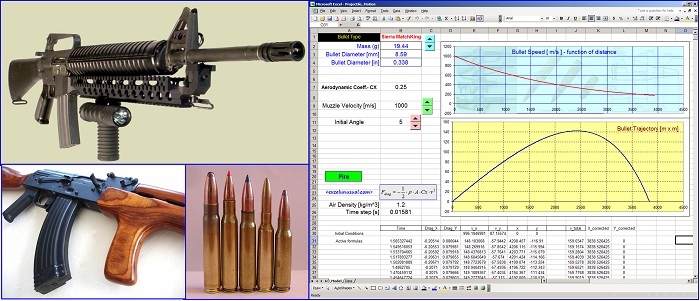This is a video preview to the shooting range model posted in February 2010. [sociallocker][/sociallocker] Read More... "A Virtual Shooting Range in Excel – video preview"


This is a video preview to the shooting range model posted in February 2010. [sociallocker][/sociallocker] Read More... "A Virtual Shooting Range in Excel – video preview"

In the this tutorial, after we got most of the trajectory calculation concentrated in just two columns, we will write a custom VBA function (dual output) to replace the spreadsheet computations used. This process of starting with very simple models, then refining the calculations and then learning how to write custom functions for those calculations will be extremely useful later for developing more complex models. [sociallocker][/sociallocker]… Read More... "2D Projectile Motion Tutorial #7"

This tutorial simplifies the previous model and manages to describe the (x,y) flight coordinates using just two formulas placed on columns D and E. A custom VBA trajectory function will be introduced in the next section which preserves the effects of gravity and aerodynamic drag. [sociallocker][/sociallocker] Projectile Motion Tutorial #5 by George Lungu – a 2D projectile motion model of projectile dynamics including… Read More... "2D Projectile Motion Tutorial #6"

This is the next in a series of projectile motion tutorials for creating 2D trajectory models using numerical analysis of projectile dynamics (including aerodynamic drag). The trajectory formulas were derived in the previous tutorial. This post describes the Excel implementation (spreadsheet formulas, VBA code, buttons and charts). [sociallocker][/sociallocker] Projectile Motion Tutorial #5 – a 2D projectile motion model using numerical analysis of projectile dynamics (including aerodynamic drag)… Read More... "2D Projectile Motion Tutorial #5"

This tutorial derives the formulas of a projectile model taking into account the aerodynamic drag. A finite differences numerical method is used. Though fairly easy to apply and understand, this type of methods can solve much more complex problems than the high-school type approach shown in the previous tutorials. An Excel model will be implemented in the next section. Projectile Motion… Read More... "2D Projectile Motion Tutorial #4"

Now that we have a simple animated projectile motion (previous tutorial) let’s try to add on the chart the three instantaneous speed vectors associated with the projectile. These speed vectors are: the horizontal speed, vertical speed and the total speed vector. The model works in all Excel versions but in 2007 it’s rather slow. [sociallocker][/sociallocker] Projectile Motion Tutorial #3 –… Read More... "2D Projectile Motion Tutorial #3"

This part of the tutorial shows you how to animate the model created in the first part. Since it is addressed to beginners, this part of the tutorial will show you in detail how to create buttons and the associated macros for the input data interface and it will also show you how to animate the flight of the projectile and explain… Read More... "2D Projectile Motion Tutorial #2"

This part of the tutorial will show you how to create the simplest possible projectile motion model using standard kinematic formulas from the first year of high school. The variable parameters of the model will be: initial height, initial speed and initial angle and time step. “g” – the gravitational constant will be set at 9.81 m/s^2. This model is a… Read More... "2D Projectile Motion Tutorial #1"

Hi Folks, As a kid was fascinated with high power rifles, sniper rifles, cannons and in general, fast projectiles. I’ve been brainwashed with all sorts of urban legends about how far an AK 47 or a pistol can shoot or how thick a steel metal plate a bullet can penetrate at various distances. I’ve also watched some documentary about snipers… Read More... "2D Projectile Motion Model #1 – a virtual tactical shooting range"